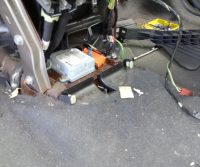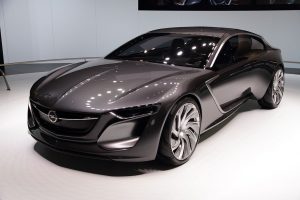Summer season is here
With the weather getting warmer we are starting to see more cars with A/C issues. Here is a Peugeot RCZ […]
READ MORE -Peugeot 206 came in from another garage. The original fault was wipers and left indicator on all the time. They fitted 2nd hand bsi which cured the faults but the car wouldn’t start because the bsi is part of the immobiliser system. So we were asked if we could help.
With the correct information and equipment we are able to swop the microprocessor containing the information from the original bsi to the 2nd hand unit
Not a simple task as you mustn’t damage the circuit board when unsoldering and reattaching chips and not shorting out the connections.
Another successful job perhaps saving a car from the breakers yard.
This hybrid Lexus was in our workshop to have a front camera fitted.
A neat professional and safe job done. Another happy customer.
 into our workshop was this Hyundai for a wiring fault. The fault was traced to behind the dashboard. As you can see here there is quite a bit of dismantling to gain access to the loom.
This Audi was towed in as a non runner,the customer saying he thought it was a immobiliser problem. We checked for spark, that was OK. We checked fuel at the rail OK. We checked compression and air, again both OK. So if all things needed to fire are present was it timing? As we checked the fuel it didn’t seem quite right. We decanted some and found this
Water in the fuel. Next we had to find out why it was there. Bad fuel from a station? Leaking fuel system? After talking to the customer he said it had been laid up for months and on examining the fuel cap which on these cars is on top of the wing if had water damage in it
So we powered up the fuel pump to drain the system, ran some fresh fuel through and drained again, fitted new filter. Finally filled her up and ran the engine.

Exterior lights faulty – Into our workshop was this lovely Mercedes GL350. The customer complaint was with the exterior lights, some not working and some on all the time so flattening the battery.
A quick serial scan showed various communication errors from the rear SAM. Access was gained and straight away the fault could be seen
Water had gotten into the module and damaged it. The module was removed and stripped to see if a repair was possible. The condition of the pcb was beyond repair.
A new genuine unit was sourced and fitted. Adaptions performed, all external lights and all other functions controlled by the SAM were checked for operation and with everything OK the customer picked up the car, happy with a first time fix with no unwanted parts and no guess work.

Airbag fault – This vehicle came in with a intermittent airbag fault. Fault codes related to left hand side crash sensor.
To gain access to sensor passenger seat was removed and the carpet lifted.
Wiring was checked for resistance between sensor and airbag module and was all good.
All power and grounds were load tested at the module and found to be good..
The module was tested faulty. A substitute module was sourced and coded to car.
Another car diagnosed correct first time. No wasted expense on unwanted parts.
 Car Battery Replacement – DIY or call an auto electrician?
Car Battery Replacement – DIY or call an auto electrician?Car Battery Replacement – If your car battery is not performing as it should be then its likely you will need to replace it. Whilst this may seem daunting to some, this is not as big a job as it sounds and may be possible to do it yourself, as long as you are careful. Faulty batteries can be very dangerous for a number of different reasons. The acid inside them is extremely corrosive and if there are any leaks it can do a lot of damage. Electricity itself is very powerful and if you connect the wrong wires to the wrong connection points then you could end up seriously injuring yourself or seriously damaging your vehicle. If you do decide to do it here are some top tips.
1. Park your vehicle on a level surface in a place with enough space to get full access to the bonnet and the engine.
2. Ensure you wear protective clothing covering your eyes and hands at all times. Battery acid is highly corrosive and can cause permanent damage if it comes into contact with your eyes or skin.
3. Before you disconnect anything, ensure that you have all of the security codes for the electrical components of your car. Radios, Sat Nav’s etc. usually ask you to put in a code once you have replaced the battery and you may not be able to use any of these features until you have entered the correct number.
4. Open the bonnet and find the battery, it shouldn’t be too difficult to locate. Most of them are next to the engine but in some makes and models of car they are to be found in the boot or under one of the seats.
5. If it is difficult to tell the wires which connect the battery apart then you should label them as positive and negative before you disconnect them. Rewiring the car in the wrong order could seriously damage the electrical system.
6. Disconnect the negative cable, making sure that the clamp doesn’t make contact with any metal components of the engine.
7. Do the same for the positive cable.
8. Carefully take the battery out of the vehicle. Be warned, batteries are quite heavy and can be awkwardly positioned so you may need another pair of hands to help you remove it safely.
9. Prepare the new battery and double check that the battery you are about to put in is the correct model for the car. Then screw the battery back in to place.
10. Reconnect the positive cable first, taking care to ensure that it is securely fastened in place and that the cable is not in the way of anything else. The clamp should be as close to the base of the post on the positive terminal as you can get it.
11. Then reconnect the negative cable, taking care to ensure that it is securely fastened in place and that the cable is not in the way of anything else. Again, the clamp should be as close to the base of the post on the negative terminal as possible. You can start the car. If the replacement has been successful, the engine will start and there will not be any warning lights on the dashboard.
12. Enter all of the security codes to restart your electrical equipment and you’re good to go!
If the car doesn’t start then there is a good chance that you have done something slightly wrong. Don’t try to correct the problem yourself unless you are 100% sure of what the problem is. You could ruin the whole of your vehicle’s electrical system which would be a much bigger job to sort out.
If all this sounds a little daunting and you don’t feel 100% confident in all these things, then you may be better taking your vehicle to a specialist auto electrician near you. The last thing you want is to do any lasting damage to your vehicle or injure yourself in any way?
 After many false dawns the electric car is finally making headway in replacing the internal combustion engine.
After many false dawns the electric car is finally making headway in replacing the internal combustion engine.The future of Electric Cars – A recent update by Transport & Environment suggests that by the end of the year there will be more than half a million battery, electric and plug-in hybrid vehicles on Europe’s roads; and sales this year should account for 1.5 percent of the market. These figures may be modest with all things considered it appears the electric car is finally forcing carmakers from their comfort zone.
Volkswagen recently launched its I.D. concept car, which is set for production in 2020 and will have an electric range of at least 400 kilometers. Herbert Diess, head of the VW brand, described the car as “revolutionary,” comparing its impact on the brand’s history to the Beetle or the Golf. This followed an earlier announcement that the VW Group aspires to get a quarter of its sales from electric by 2025 and is planning 20 models.
Mercedes launched an equivalent Generation EQ concept car that will become a new sub-brand with at least 10 plug-in models.In other announcements, Vauxhall unveiled the Ampera-e and Renault and BMW detailed upgrades of the Zoe and i3 respectively, with Renault commenting: “Our vision of the electric market is that it is not a niche market.”
The future of Electric Cars – Fears that electric cars will decimate the value of the important European automotive sector also appear to be unfounded. VW has outlined plans for a €10 billion battery factory; Samsung SDI is to invest €320 million to build an electric-vehicle battery plant in Hungary; meanwhile LG Chem is reported to be planning a factory in Wrocław, Poland. Independent studies estimate that the shift will create between 500,000 and 1 million jobs by 2030.
Electric cars are not a panacea but together with e-bikes, electric scooters, trains and trams, they will provide the opportunity for a cleaner, greener mobility future that assigns dirty diesel cars and trains, which choke cities and commuters, to the scrapyard of obsolescence. It is no longer a question of whether this happens — but how quickly.